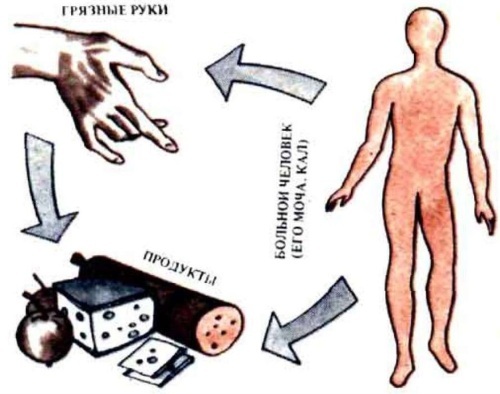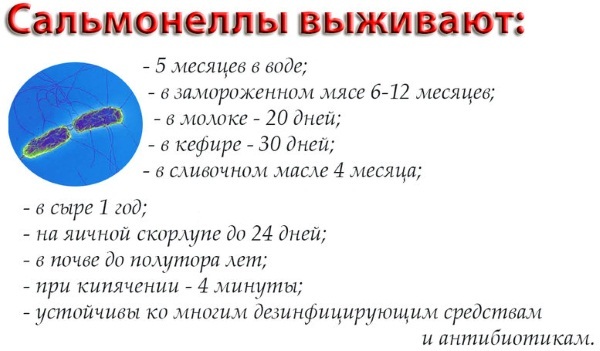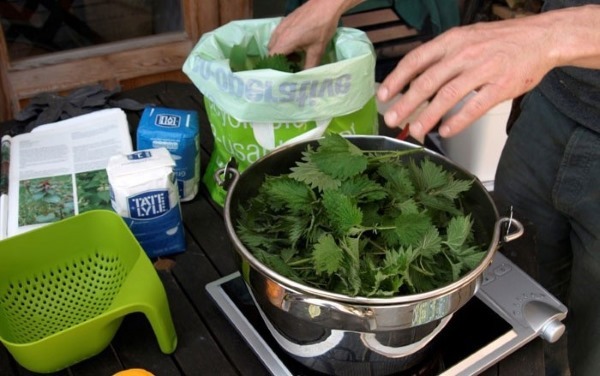Such transmission route, as alimentary, characterized by the penetration of pathogenic microflora into the human body through water and food. This infection mechanism is not specific to parasites only. There is a risk of contamination with viral agents and pathogenic bacteria through drinks and food.
Record content:
- 1 What is the alimentary route of infection?
- 2 Infection transmission mechanism
- 3 The form of tularemia arising from the alimentary route of infection
- 4 Possible diseases transmitted by this route
- 5 Foods that may contain pathogens
- 6 General principles for the treatment of such diseases
- 7 Video about the transmission of diseases
What is the alimentary route of infection?
Alimentary transmission is the penetration of various forms of pathogenic microorganisms into the human body through the oral cavity. Infection occurs when eating foods, water and sugary drinks that contain colonies of bacteria, viruses, or parasite eggs. It is often possible to become infected by contact of the lips and mucous membranes of the mouth with animal hair and the skin of unwashed hands.
As a result, there are 2 main ways of infection:
- Waterway. If microorganisms enter the central water supply system of large cities, if the filters are broken, it can lead to massive infection of people, an epidemic. The causative agents of infection penetrate into the water together with the feces of animals or contaminated food.
-
Food route. Infection occurs during food intake, which contains pathogenic microflora. The reason for the habitation of parasites or bacteria in products is a violation of sanitary standards in the kitchen, the lack of heat treatment. Insects often become temporary carriers of infection. For example, in the process of vital activity of flies, bacteria from their paws enter human food.

An alternative name for alimentary transmission of infection is the fecal-oral route. In most cases, in this way, a person becomes infected with parasitic forms of protozoan bacteria and helminths. The excretion of eggs and waste products of pathogenic microflora occurs together with feces.
Infection transmission mechanism
Alimentary transmission is a mode of infection that is divided into 3 sequential phases:
- Removal of a new pathogen from the digestive tract of the previous host organism.
- Being in a state of suspended animation in the external environment or staying in the body of a temporary carrier. These include mainly insects.
- Penetration of pathogenic microflora into a new host organism.
As an example, we can consider the transmission of helminths through flies. Adult parasites lay eggs in the intestines of an animal or human, which are removed from the digestive tract with feces.
Flies can get nutrients from feces, so they sit on feces. Helminth eggs can attach to the hairs on the paws. The embryos of parasites are completely protected from mechanical damage, so they do not die during the flight and fall of the insect.

After contact with the feces of the previous host organism, flies in the process of vital activity can sit on freshly prepared food. In this case, the embryos of helminths attach to a more sticky surface: for example, sauces, desserts, sugary drinks, cut fruits.
A person eats food together with helminth eggs. Upon entering a susceptible organism, the embryos begin to develop and the mechanism of fecal-oral transmission of infection begins anew.
Similarly, infection occurs when the mucous membranes of the mouth come into contact with dirty hands, household items, pets and outdoor animals. Infection with pathogenic microflora is observed regardless of the type of food, at any stage of food transportation from the place of manufacture to the consumer.
The way parasites, viruses and bacteria are introduced into food differ:
- when touching food of people with dirty hands, animals, birds, insects;
- contact of plant and animal products with soil contaminated with water, household items;
- transfer of parasite eggs to food by airborne droplets or dust.
People can become infected by eating meat and dairy products obtained from contaminated animals, if these products have not been subjected to the necessary heat treatment. Most often, children in educational institutions get sick through milk, ice cream and sour cream.
If vomit, feces of infected people or animals get into the water, then when drinking the liquid there is a risk of infection with typhoid fever, shigellosis, tularemia.
Bacteria quickly spread through sealed sources such as ponds and wells. Pathogenic microflora can get into natural water bodies when sewage is discharged. The most dangerous waterborne disease is cholera.
Alimentary transmission is the only way of infection for some types of helminthiasis. For diseases such as dysentery, cholera, or salmonellosis, fecal-oral transport is the predominant or one of the likely means of infection. Diphtheria and tonsillitis are rarely transmitted by the alimentary route.
The form of tularemia arising from the alimentary route of infection
The alimentary route for tularemia is one of the possible modes of transmission, but not the main one.
This is due to the fact that there are 7 types of infectious diseases, depending on the location of the bacteria:
- bubonic;
- abdominal;
- angina-bubonic;
- pulmonary;
- ulcerative bubonic;
- generalized;
- eye-bubonic.
The fecal-oral route of infection is characterized only by the abdominal form of tularemia. The disease is characterized by the general clinical picture of intestinal infection: a person loses fluid due to regular vomiting and diarrhea, due to which dehydration occurs, water-electrolyte balance.
The patient develops a fever, there are severe pains in the abdomen. If untreated, the bacterial microflora that has settled in the intestine damages the organ wall and the vessels located in it. As a result, the disease is complicated by internal bleeding.
Possible diseases transmitted by this route
Alimentary transmission is the defeat of the digestive system by pathogenic microorganisms. The mechanism of infection involves not only animal products obtained from sick cattle.
Fruits and vegetables that come into contact with the ground or with people's dirty hands can also be contaminated. This is due to the fact that the eggs of parasites ripen in the soil and cysts are located - a temporary form of the existence of bacteria, in which they are protected from temperature extremes and damage.
You can see the possible diseases transmitted by the fecal-oral route in the following table.
| Name | Features of pathology |
| Abdominal tuberculosis | A person becomes infected by drinking the milk of a sick cow. The extrapulmonary form of tuberculosis is not transmitted through meat, because the bacteria die when it is cooked on the stove. |
| Rotavirus disease, stomach flu | RNA viruses often infect children due to non-compliance with sanitary standards, causing severe diarrhea. Microorganisms penetrate the cells of the small intestine, actively release enterotoxins into the blood. Because of them, systemic poisoning occurs, there is a disorder of the stool and the development of enterocolitis. Rotavirus type A is found in 90% of children. After recovery, the child develops specific immunity, therefore, with repeated infection, the disease is less acute. |
| Brucellosis | It is transmitted through raw dairy products and meat obtained from infected animals. Brucellosis often affects goats, cattle and sheep, in rare cases, pigs.
|
| Enteroviruses | Of the 66 types of enteroviruses, the most famous are:
|
| Yersiniosis | A person becomes infected by eating plant and animal products. As the pathology progresses, the colony of Yersinia grows, the waste products of bacteria enter the blood. With the help of the vascular system, toxins are carried to all tissues, affecting a number of organs, nerves and muscles. |
| Abdominal tularemia | Food contamination occurs from rodents, rats and field mice inhabiting grain stores. |
| Anthrax, abdominal form | It is transmitted by contact of the oral mucosa with dirty hands. Transmission through plant products and meat of herbivores is possible. The symptoms of zooanthroponosis are similar to purulent appendicitis, which makes it difficult to diagnose the disease in the early stages. |
| Hepatitis A virus | Despite the fact that the HAV virus is often transmitted by the nutritional route, it does not affect the intestines, but the liver cells. The incubation period of the disease lasts from 15 to 50 days, after which acute symptoms begin to appear:
The disease responds well to drug therapy, so the mortality rate from the hepatitis A virus is 0.5%. |
| Shiggelez | Pathogenic microflora attaches to the mucous membranes in the large intestine. Human infection occurs when eating unwashed fruits and vegetables that have come into contact with the soil. |
| Foot and mouth disease | Refers to viral intestinal infections. Does not die at sudden temperature changes. It is preserved in meat and milk of sick animals even after freezing. Dies during heat treatment of products. The disease is characterized by inflammation of the intestinal mucosa, the development of severe fever and skin rash. |
| Dietary form of salmonellosis | Salmonella infection occurs through the consumption of any food of animal origin. Bacteria are killed by prolonged heat treatment.
|
| Gastritis and enteritis caused by Helicobacter pylori | Small colonies of bacteria normally inhabit the stomach and duodenum without causing digestive upset. In 80% of cases, the person acts as a carrier that is not harmed by Helicobacter. With an immunodeficiency state, against the background of chronic diseases, bacteria begin to multiply actively. Large colonies cause gastritis, lead to peptic ulcer disease. To exist in the stomach, the bacterium breaks down urea into ammonium and carbon dioxide. These reaction products neutralize the digestive juices and allow the microflora to survive on the mucous membrane. Normally, this does not harm a person, but if a large amount of Helicobacter pylori begins to simultaneously release ammonium, then stomach cells will begin to collapse. As a result, a focus of inflammation arises, which provokes the occurrence of ulcers and gastritis. In 10% of cases, in the absence of treatment, stomach cancer develops. |
| Dysentery | Amoebas get into the water, attach themselves to the shells of fruits and vegetables. Protozoa cause acute symptoms of intestinal infection. |
| Cholera | Vibiron cholerae is waterborne contaminated seafood. Causes profuse vomiting and diarrhea, due to which the human body loses a large amount of fluid. There is a risk of death from dehydration. |
When infected with pathogenic microorganisms in humans, the general symptoms of gastrointestinal disorder are manifested:
- increased acidity of digestive juice, heartburn;
- decreased appetite;
- nausea;
- dehydration due to vomiting and diarrhea;
- the presence of blood clots, mucus in the liquid feces;
- a feeling of discomfort in the abdominal cavity, acute pain;
- increased gas production in the intestines, bloating.
Viral infections are most often transmitted by waterborne infection. If not boiled, the liquid can be used for cooking. In this way, viruses spread from untreated water to food. A person can become infected with hepatitis A or Botkin's disease.
Bacterial intestinal infections are mainly transmitted through food of animal origin. Parasitic diseases are carried by insects. Helminth eggs can get caught on the skins of plant foods when ripe fruits and vegetables fall to the ground.
Foods that may contain pathogens
Pathogens of intestinal infections, with the exception of parasite eggs, can multiply on food.
Pathogenic microflora is found on the following types of food:
-
Confectionery. Contains a cream that could be prepared from the milk of a sick animal.

- Vegetables and leafy greens. Infected with Yersinia. These bacteria survive even at low temperatures, so they do not die when plant products are stored in the main compartment of the refrigerator.
- Animal products: fish fillets, meat, dairy products and eggs. Often infected with salmonellosis.
- Fruits, vegetables, tubers. May be contaminated with shigella and amoeba on contact with soil.
- Seafood: shrimp, scallops, mussels. When infected in the aquatic environment, they become carriers of Vibrio cholerae.
Insects sit on food cooked and left in the open air. They carry bacteria on their paws without getting infected themselves.
General principles for the treatment of such diseases
Each intestinal infection requires an individualized approach. Diagnostics and drug therapy are selected depending on the symptoms and the severity of the pathological process. In the initial stages of the disease without complications, they are characterized by the development of vomiting, diarrhea and acute pain in the abdomen.
Due to similar symptoms, infectious disease specialists prescribe general principles of treatment:
- Abundant water regime. Vomiting and diarrhea causes the body to become dehydrated and lose electrolytes. To replenish fluid, the patient needs to drink as much mineral water as possible.
- Reception of Polysorb, activated carbon. Absorbent substances prevent further absorption of toxins released by pathogenic microflora into the blood.
- Prescription of antipyretic medications. Necessary at the peak of fever, when the body temperature rises to + 38... + 39 ° C. It appears as a result of blood poisoning by the waste products of viruses, parasites and bacteria.
- Taking antihistamines. In response to the ingestion of pathogenic microflora, allergies may develop. It manifests itself in the form of a skin rash and itching.
The general treatment regimen allows you to alleviate the symptoms of pathology while the analysis of feces is being performed. This is necessary in order to establish the type of pathogen of intestinal infection and begin specific therapy.
To reduce the risk of infection with pathogenic microflora, it is recommended to adhere to the following preventive measures:
- observe personal hygiene;
- wash hands with soap and water before eating;

- do not touch your lips or put foreign objects in your mouth;
- do not drink from open sources, it is advisable to treat liquid from natural reservoirs with tablets to disinfect water;
- during an epidemic, wear a gauze bandage, avoid places with a large crowd of people;
- limit contact with infected people, when caring for patients, you need to work with a mask and gloves.
It is forbidden to treat the disease yourself. Otherwise, severe complications may develop: internal bleeding, sepsis. If you suspect a fecal-oral infection, you must be examined by an infectious disease doctor.
As a result of the alimentary pathway of infection with pathogenic microflora, gastrointestinal infections occur.
This type of transmission is possible through the consumption of food and drinks, with which insect vectors and sick people have come into contact, as well as through contact with dirty hands, animal hair. After the incubation period, the patient develops dehydration, vomiting, diarrhea and abdominal pain.
Video about the transmission of diseases
Immunologist on the ways of transmission of infections:



